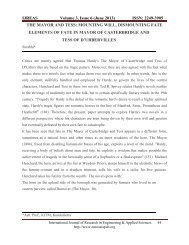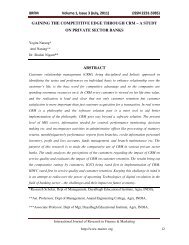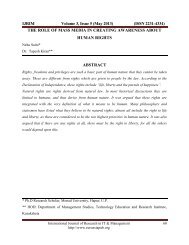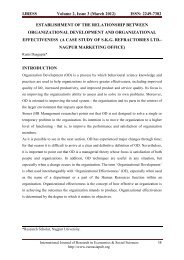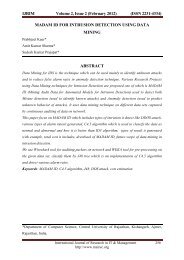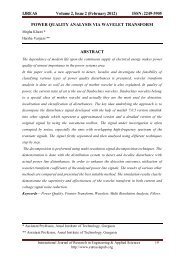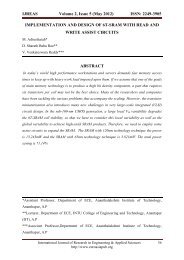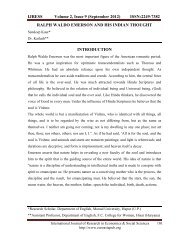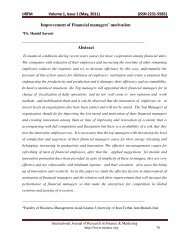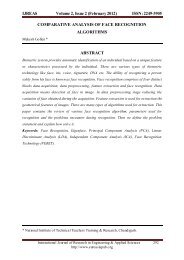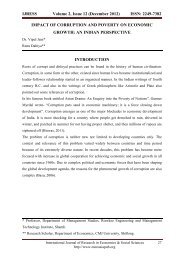scope of biodiesel in india - Euroasiapub.org
scope of biodiesel in india - Euroasiapub.org
scope of biodiesel in india - Euroasiapub.org
You also want an ePaper? Increase the reach of your titles
YUMPU automatically turns print PDFs into web optimized ePapers that Google loves.
IJREAS Volume 2, Issue 8 (August 2012) ISSN: 2249-3905<br />
Consumption<br />
Both SVO and <strong>biodiesel</strong> are suitable for f<strong>in</strong>al consumption. SVO can be used for light<strong>in</strong>g<br />
(replac<strong>in</strong>g petroleum <strong>in</strong> lamps) and cook<strong>in</strong>g (<strong>in</strong> specially designed cook<strong>in</strong>g stoves). It can<br />
also replace conventional diesel <strong>in</strong> eng<strong>in</strong>es (e.g. electricity<br />
generators or water pumps). S<strong>in</strong>ce SVO has very high viscosity, however, fuel <strong>in</strong>jection<br />
pumps need to be modified, otherwise eng<strong>in</strong>es will abrade much faster. Hence, operational<br />
and ma<strong>in</strong>tenance costs <strong>of</strong> eng<strong>in</strong>es runn<strong>in</strong>g on SVO are higher than for those runn<strong>in</strong>g on<br />
conventional diesel. The fuel properties <strong>of</strong> <strong>biodiesel</strong>, on the other hand, are a lot better than<br />
those <strong>of</strong> SVO. Thus, replac<strong>in</strong>g diesel with <strong>biodiesel</strong> <strong>in</strong>stead <strong>of</strong> SVO reduces operational and<br />
ma<strong>in</strong>tenance costs. Some projects aim<strong>in</strong>g at rural energy security use SVO for their mach<strong>in</strong>es<br />
and electricity generators, while others first transesterificate and use <strong>biodiesel</strong> for the same<br />
purposes. The advantages <strong>of</strong> the latter are better fuel properties, lead<strong>in</strong>g to more efficient fuel<br />
combustion and less pollution. There are, however, economic and safety issues associated<br />
with the process <strong>of</strong> transesterification. Additional technology and equipment as well as other<br />
<strong>in</strong>puts (methanol, catalyst) are needed to process SVO <strong>in</strong>to <strong>biodiesel</strong>. This means additional<br />
costs both for <strong>in</strong>vestment and ma<strong>in</strong>tenance. Also, qualified personBiodiesel <strong>in</strong> India nel has<br />
to be tra<strong>in</strong>ed to operate the complicated transesterification process. These issues, however,<br />
could be resolved with careful plann<strong>in</strong>g and implementation. One solution to this problem <strong>of</strong><br />
viscosity is to blend diesel with either SVO or <strong>biodiesel</strong>. An SVO-diesel blend, though, still<br />
requires a modification <strong>of</strong> the eng<strong>in</strong>e for proper function<strong>in</strong>g <strong>in</strong> most cases. The characteristics<br />
<strong>of</strong> the SVO may vary a lot due to differences <strong>in</strong> seed quality and extraction methods.<br />
Therefore, the percentage up to which a blend<strong>in</strong>g <strong>of</strong> diesel with SVO is possible depends <strong>in</strong><br />
large measure on SVO quality and eng<strong>in</strong>e type. By contrast, the characteristics <strong>of</strong> <strong>biodiesel</strong><br />
are rather consistent because <strong>of</strong> the standardized chemical reaction processes dur<strong>in</strong>g<br />
transesterification. Blend<strong>in</strong>g diesel with <strong>biodiesel</strong> is therefore much more efficient.<br />
Depend<strong>in</strong>g on the study consulted, blend<strong>in</strong>g <strong>of</strong> up to 50 % is possible without any major<br />
operational difficulties for eng<strong>in</strong>es (Jongschaap et al. 2007, 15). By-products and alternate<br />
uses <strong>of</strong> SVO and <strong>biodiesel</strong> Several by-products have economic value. Oil-bear<strong>in</strong>g trees not<br />
only produce seeds/fruits, their leaves, latex and wood can also be used. Leaves <strong>of</strong> some<br />
oilbear<strong>in</strong>g trees can serve as valuable <strong>org</strong>anic fertiliser,7 and both leaves and latex <strong>of</strong> some<br />
species are used for medic<strong>in</strong>al purposes. When trees or bushes are pruned, branches can be<br />
used as firewood or – like any other biomass – for biogas production. Furthermore, fruit hulls<br />
may serve for all the possible uses mentioned above – as <strong>org</strong>anic fertiliser, for burn<strong>in</strong>g, for<br />
medic<strong>in</strong>al purposes as well as for biogas production. Two other important by-products <strong>of</strong><br />
International Journal <strong>of</strong> Research <strong>in</strong> Eng<strong>in</strong>eer<strong>in</strong>g & Applied Sciences 8<br />
http://www.euroasiapub.<strong>org</strong>



